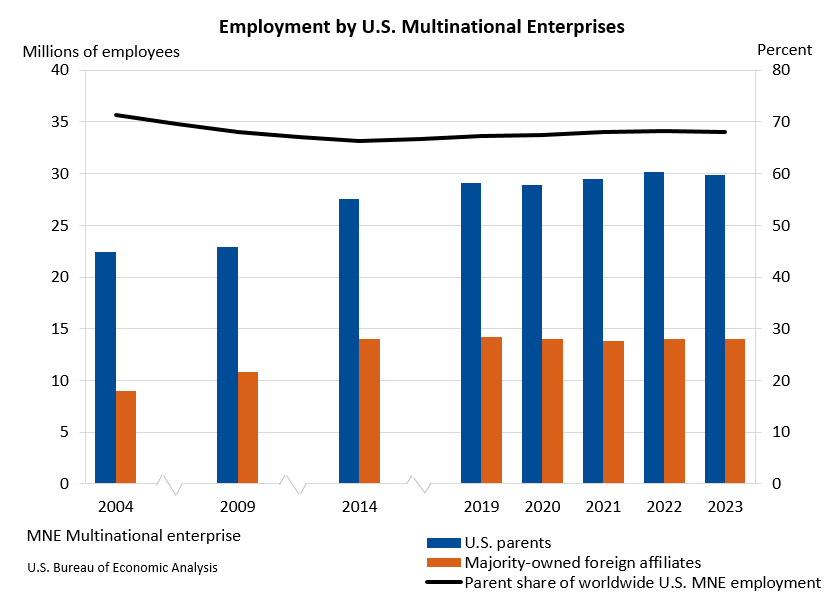Bureau of Economic Analysis
Activities of U.S. Multinational Enterprises, 2023
Worldwide employment by U.S. multinational enterprises decreased 0.4 percent to 43.9 million workers in 2023 (preliminary) from 44.1 million workers in 2022 (revised), according to statistics released today by the U.S. Bureau of Economic Analysis on the operations and finances of U.S. parent companies and their foreign affiliates.
Principal Federal Economic Indicators
Noteworthy
- 2025 News Release Schedule
- Innovation at BEA
- 2025 Annual Updates
- Distribution of Personal Income Nowcast
- New! Services Trade Data for More Countries
- Data Tool: Trade in Value Added
- Updated: RIMS II Regional Multipliers
- Arts and Culture
- Space Economy
- FDI Now in State BEARFACTS
- Quick Guide: Price Indexes
The Latest
New Foreign Direct Investment in the United States, 2019
Expenditures by foreign direct investors to acquire, establish, or expand U.S. businesses totaled $194.7 billion in 2019, down 37.7 percent from $312.5 billion in 2018.
U.S. International Investment Position Year 2019
The U.S. net international investment position, the difference between U.S. residents’ foreign financial assets and liabilities, was –$11.05 trillion at the end of 2019, according to statistics released by the U.S. Bureau of Economic Analysis (BEA). Assets totaled $29.15 trillion and liabilities were $40.20 trillion. At the end of 2018, the net investment position was –$9.67 trillion.
U.S. International Investment Position First Quarter 2020
The U.S. net international investment position, the difference between U.S. residents’ foreign financial assets and liabilities, was –$12.06 trillion at the end of the first quarter of 2020, according to statistics released by the U.S. Bureau of Economic Analysis. Assets totaled $26.77 trillion and liabilities were $38.82 trillion. At the end of the fourth quarter of 2019, the net investment position was –$11.05 trillion.
U.S. International Investment Position, First Quarter 2020, Year 2019, and Annual Update
The U.S. net international investment position, the difference between U.S. residents’ foreign financial assets and liabilities, was –$12.06 trillion at the end of the first quarter of 2020, according to statistics released by the U.S. Bureau of Economic Analysis (BEA). Assets totaled $26.77 trillion and liabilities were $38.82 trillion. At the end of the fourth quarter of 2019, the net investment position was –$11.05 trillion.
Personal Income and Outlays, May 2020
Personal Income Personal income decreased 4.2 percent while consumer spending increased 8.2 percent in May, according to estimates released today by the Bureau of Economic Analysis.
Personal Income and Outlays: May 2020
Personal income decreased 4.2 percent while consumer spending increased 8.2 percent in May, according to estimates released today by the Bureau of Economic Analysis.
Gross Domestic Product, First Quarter 2020
Real gross domestic product (GDP) decreased 5.0 percent in the first quarter of 2020, according to the “third” estimate released by the Bureau of Economic Analysis. The decline is the same as in the “second” estimate released in May. In the fourth quarter of 2019, real GDP increased 2.1 percent. For more information, see the Technical Note.
Gross Domestic Product, 1st Quarter 2020 (Third Estimate); Corporate Profits, 1st Quarter 2020 (Revised Estimate)
Real gross domestic product (GDP) decreased 5.0 percent in the first quarter of 2020, according to the “third” estimate released by the Bureau of Economic Analysis. The decline is the same as in the “second” estimate released in May. In the fourth quarter of 2019, real GDP increased 2.1 percent.
Personal Income by State, 1st Quarter 2020
State personal income increased 2.3 percent at an annual rate in the first quarter of 2020, a deceleration from the 3.6 percent increase in the fourth quarter of 2019. The percent change in personal income across all states ranged from 4.9 percent in New Mexico to -0.3 percent in Michigan.
Personal Income by State, 1st Quarter 2020
State personal income increased 2.3 percent at an annual rate in the first quarter of 2020, a deceleration from the 3.6 percent increase in the fourth quarter of 2019. The percent change in personal income across all states ranged from 4.9 percent in New Mexico to -0.3 percent in Michigan.




